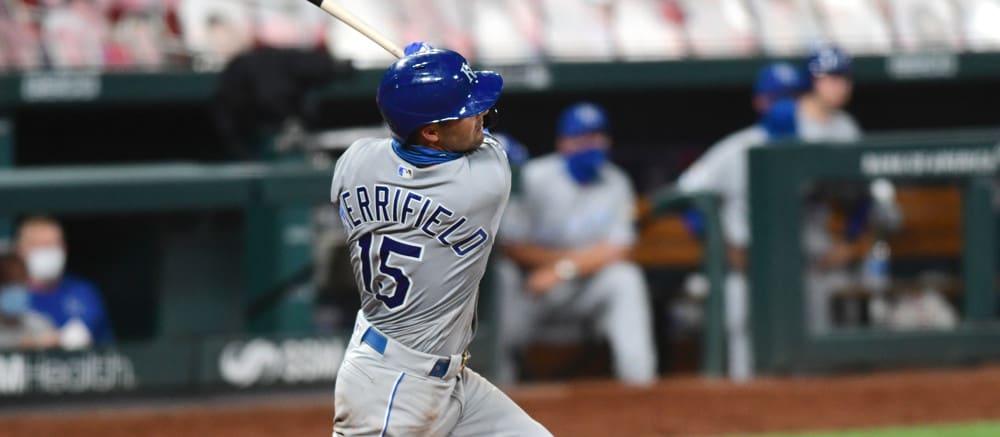This article is part of our The Z Files series.
Hey everyone, bring it in. I have a confession. You know the way I've been railing on anyone talking about the quarter pole after around 40 games of the MLB season? Well, using it with 40 games remaining is also improper. The quarter pole tells the jockeys there is one-quarter of a mile left in the race, regardless of the total distance.
Therefore, if a season is a marathon, each week is one mile. As such, the quarter pole is somewhere between two and two games left on the schedule. You try explaining that to my Twitter followers.
Now that I have that off my chest, let's turn our attention to baseball and some observations I'd like to share.
The Not-So-Dog Days of August?
Many stats generally follow a similar monthly trend year after year. The driving force is usually weather. There are exceptions, which we'll soon see. Let's look at a few of them in graphical form. In each instance, August numbers are through the 23rd of the month.
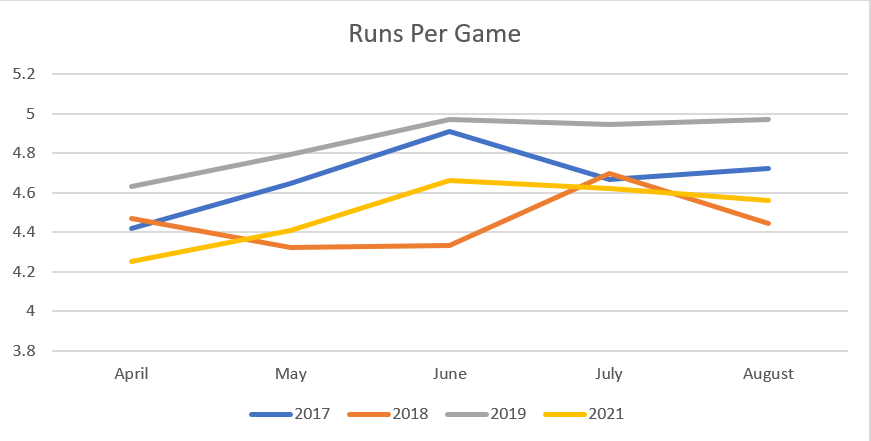
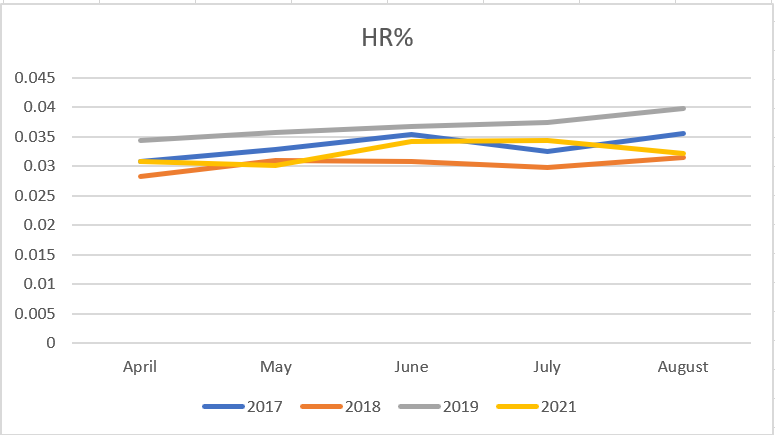
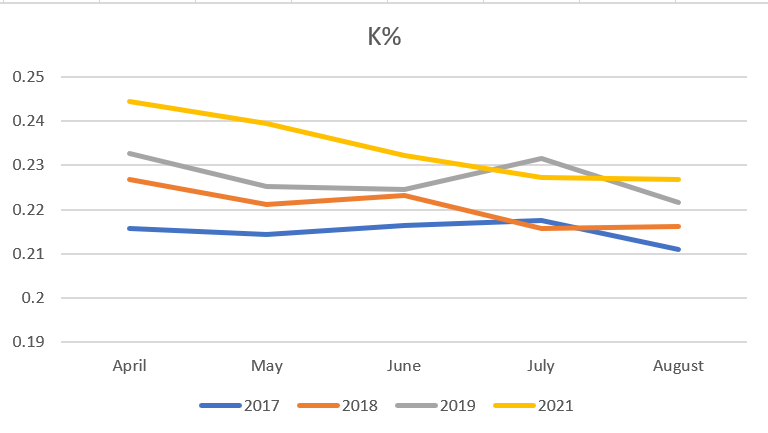
I've tracked this for many seasons and 2018 is wacky. We're trending towards another outlier campaign this season. I don't have an explanation for 2018 other than variance. Perhaps a study on monthly temperatures is warranted.
The two trends catching my eye are seeing homers and strikeouts drop at the same time. Shouldn't they move in opposite directions? With respect to the falling K%, it generally declines over the course of the season; this season the dip is steeper.
Let's
Hey everyone, bring it in. I have a confession. You know the way I've been railing on anyone talking about the quarter pole after around 40 games of the MLB season? Well, using it with 40 games remaining is also improper. The quarter pole tells the jockeys there is one-quarter of a mile left in the race, regardless of the total distance.
Therefore, if a season is a marathon, each week is one mile. As such, the quarter pole is somewhere between two and two games left on the schedule. You try explaining that to my Twitter followers.
Now that I have that off my chest, let's turn our attention to baseball and some observations I'd like to share.
The Not-So-Dog Days of August?
Many stats generally follow a similar monthly trend year after year. The driving force is usually weather. There are exceptions, which we'll soon see. Let's look at a few of them in graphical form. In each instance, August numbers are through the 23rd of the month.



I've tracked this for many seasons and 2018 is wacky. We're trending towards another outlier campaign this season. I don't have an explanation for 2018 other than variance. Perhaps a study on monthly temperatures is warranted.
The two trends catching my eye are seeing homers and strikeouts drop at the same time. Shouldn't they move in opposite directions? With respect to the falling K%, it generally declines over the course of the season; this season the dip is steeper.
Let's cut to the chase. This is all a setup for the real question: what's happening with the whole spin thing?
Here are some more charts, looking at the spin rate for four-seam fastballs, curves and sliders over the following time frames:
- April
- May
- June 1 - June 20
- June 21 - July 11
- July 15 - August 22
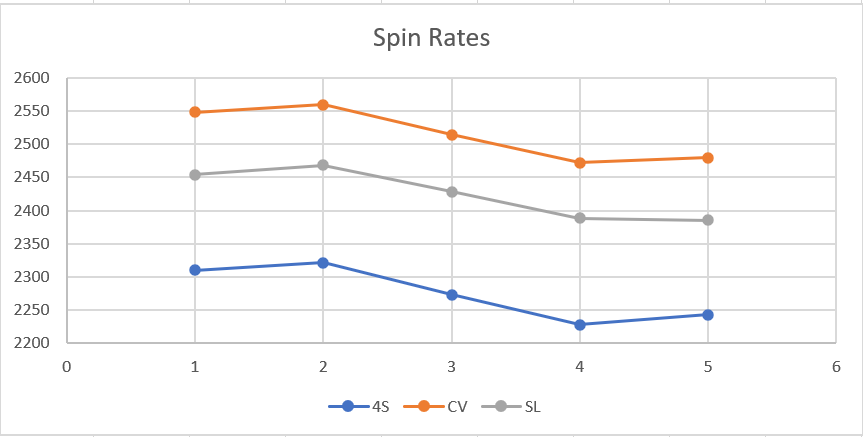
Remember, umpires did not begin checking for grip enhancers until June 21, but there was advance notice and it is apparent some pitchers changed their habits before actually being checked. The All-Star break was chosen somewhat arbitrarily to parse the time after umpires began looking at hats, gloves and belts. That said, there is a continual decline until spin rates leveled off once those checks began.
Circling back to the home run and strikeout data, it makes sense punchouts decline as spin drops, since the offerings are ostensibly less effective. If that's the case, shouldn't homers increase? Not only are more balls in play, but there is less movement which should result in more solid contact.
The weather this season has been, well, different. It was hotter than usual early and cooler than normal later. It has also been a wetter summer than usual. All of this ignores the possibility MLB isn't transparent with respect to the consistency of the baseball. That said, I am likely too trusting and take them at their word in assuming the ball has been the same all season.
Other than just finding these results somewhere between intriguing and interesting, there are some practical applications. Fewer homers and strikeouts result in more compact fantasy standings. Of course, the inventory of each is lessened, but if you pay extra heed to maximizing playing time, either in terms of volume or efficiency, it could be easier to close gaps this season.
For those curious about maximizing efficiency, this is more apropos to pitching, though some formats (Ottoneu, for example) have game limits for batters. The idea is it isn't just about having someone active all the time -- with playing time limits, counting stats essentially turn into ratios. It's easiest to demonstrate with strikeouts in a format with an innings cap. Let's say everyone reaches the maximum. Who wins the K category? It's the team with the highest K/9. That is, don't waste a start on a pitcher with low strikeout potential, unless you absolutely require the help with ERA and/or WHIP. When it comes to batters, it's more about avoiding the worst matchups. This is more applicable in daily leagues, but maybe Rafael Devers should be on the bench against a tough southpaw. I'm not singling out Devers but rather suggesting being more prudent with matchups, especially if you have a deep bench and can use Kyle Seager against a weak righty instead.
The Bronx Burners
Guess which team leads the league in steals since the break? Gotcha! No, it's not the Yankees, though they are a surprising fourth. In fact, what's more surprising is the top five clubs all reside in the Junior Circuit.
| Rank | Team | SB | CS |
|---|---|---|---|
| 1 | Kansas City Royals | 35 | 7 |
| 2 | Oakland Athletics | 34 | 4 |
| 3 | Cleveland Indians | 32 | 5 |
| 4 | New York Yankees | 31 | 5 |
| 5 | Los Angeles Angels | 24 | 9 |
| 6 | Miami Marlins | 20 | 6 |
| 7 | Los Angeles Dodgers | 19 | 3 |
| 8 | Milwaukee Brewers | 18 | 3 |
| 9 | St. Louis Cardinals | 17 | 4 |
| 10 | Toronto Blue Jays | 16 | 3 |
| 11 | Texas Rangers | 15 | 5 |
| 11 | Chicago White Sox | 15 | 2 |
| 11 | San Francisco Giants | 15 | 1 |
| 11 | Philadelphia Phillies | 15 | 9 |
| 15 | Baltimore Orioles | 14 | 7 |
| 16 | Chicago Cubs | 13 | 10 |
| 16 | San Diego Padres | 13 | 8 |
| 18 | Detroit Tigers | 12 | 4 |
| 18 | Seattle Mariners | 12 | 7 |
| 20 | Houston Astros | 11 | 2 |
| 20 | Arizona Diamondbacks | 11 | 2 |
| 22 | Atlanta Braves | 10 | 1 |
| 22 | Colorado Rockies | 10 | 5 |
| 24 | Tampa Bay Rays | 8 | 7 |
| 24 | Washington Nationals | 8 | 3 |
| 24 | Pittsburgh Pirates | 8 | 6 |
| 24 | New York Mets | 8 | 2 |
| 24 | Minnesota Twins | 8 | 6 |
| 29 | Boston Red Sox | 2 | 6 |
| 29 | Cincinnati Reds | 2 | 3 |
Whit Merrifield leads the Royals with 13 second-half pilfers followed by Nicky Lopez with 10, most coming recently after being promoted to the two-hole. Michael Taylor has five.
Starling Marte has a silly 17 bags since being acquired by the Athletics, accounting for half of their second-half total. Next up is Mark Canha with four, followed by Josh Harrison, Elvis Andrus and Seth Brown, all with three. I guess they missed the scene in Moneyball where Brad Pitt, I mean Billy Beane, said not to steal bases.
To no one's amazement, Jose Ramirez is pacing Cleveland with eight. However, Bradley Zimmer with five is an eye-opener. Myles Straw only has four; it seems like he should have collected a few more. Amed Rosario also has four.
Tyler Wade has been busy for the Yankees, swiping eight. Gleyber Torres is making up for a disappointing season with half a dozen while Greg Allen nabbed five before being sent to the farm.
The Angels are a bit of a surprise, though it's not at all shocking to see Shohei Ohtani on top with seven, the same number as David Fletcher.
At the other end of the spectrum are the Reds and Red Sox, a couple of teams with a handful of players expected to run, but which thus far have amassed only two each.
The two names I find most enticing are Lopez and Fletcher. Both lack power, but they hit toward the top of their respective lineups and have turned into three-category contributors. It all depends on what you stand to gain and lose, but both are in play if you can do without the pop.

